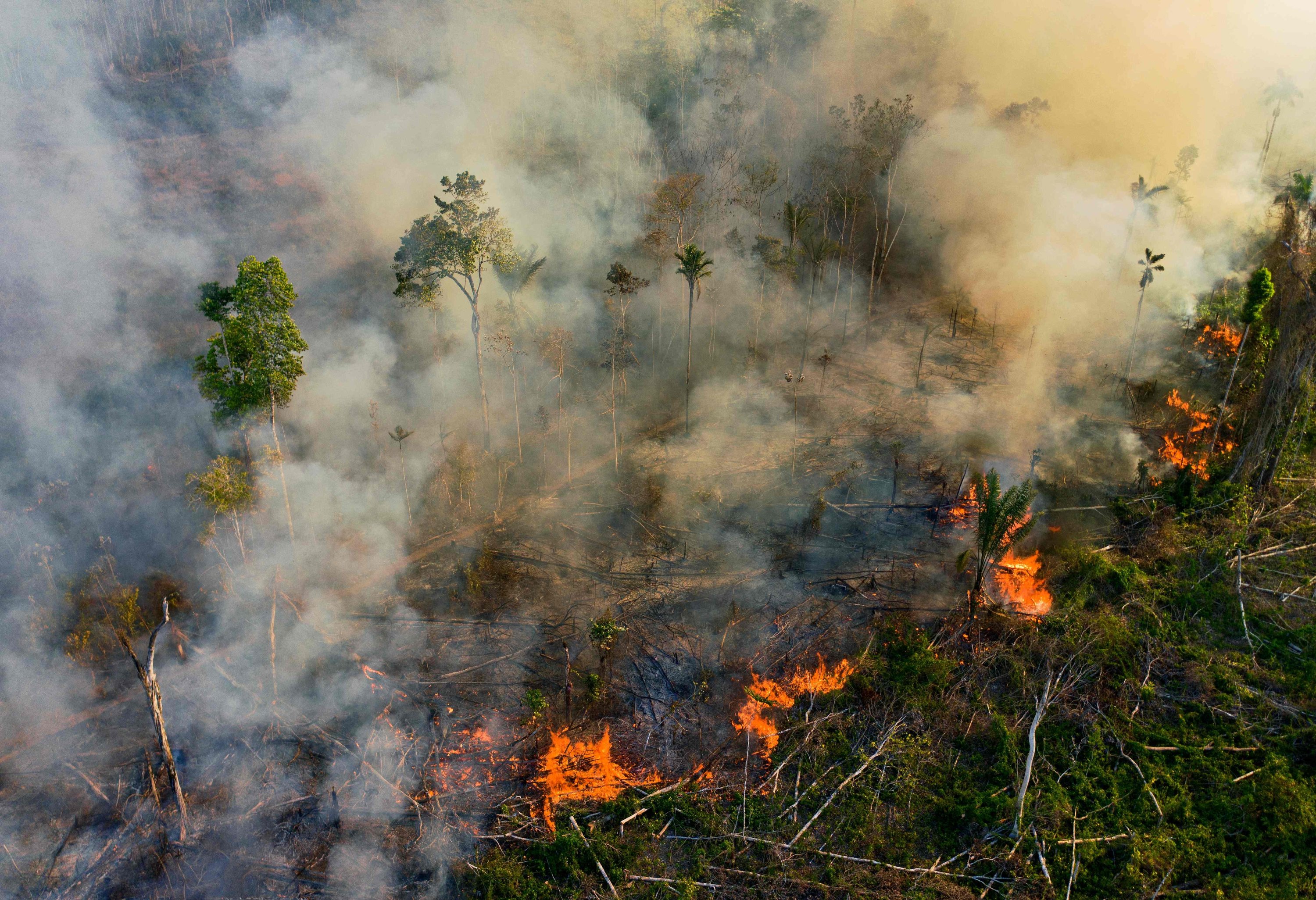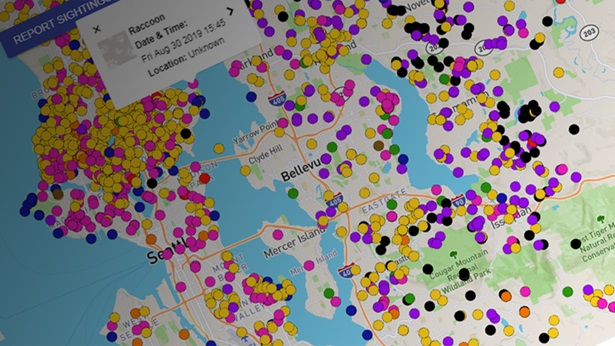Introduction
Wildfire devastation is not simply contained to the natural environment across grasslands and forests. Fires often force vegetation and wildlife to the edge of death due to habitat destruction. With the lessening amounts of forestry available to reside in, as well as the altering patters of migration, wildlife on the ground and in the air are forced to uproot their origins and relocate to an atypical settings. However, the impact of that relocation can have direct effects upon humans who have already dominated the land for hundreds of years. With the lack of options to survive the burning landscape, the impact on wildlife habitats, burning vegetation, and humanitarian diversity will suffer to different extents until wildfire control and sustainable is properly contained and managed.

Wildlife Destruction
Across the land, wildfire destruction creates habitat problems for wildlife of all regions. However, the western United States often sees the most significant damage and longest timelines to recover from these fires. Much of the west suffers from replacement rates of 35-100 years. With 35 years averaging as the bare minimum, species have the potential to begin to die out prior to that window beginning to open. With such a vast amount of time until groundcover and forestry can recover, the bare land is now highly vulnerable for significant flash flooding, land slides, and additional hazards that will enhance the lost vegetation across the region. Regions along and west of Interstate 5 across the Pacific Northwest see a replacement rate of 201-500 years or longer within the forested and woodland regions. Although states across the eastern third of the county see wildfire concerns as well, the frequency of those fires is substantially lower. The replacement rates of all vegetation types is also lower compared to those across the west where the climate is overall drier and hotter. According to Fire Ecology, vegetation is likely to increase in burned amounts by five times the current rate by 2039, compared to 2010. With vegetation struggling to grow after the initial fire, wildlife is forced to seek shelter and rehome in different regions across the country. Some species may also migrate to other countries with similar climates. However, those species that do stay must now adapt to the changed landscape.

Adaptation can arguably be the most impressive feature of a species that suffers through life changing wildfires. Those species have the option to maintain their original home and adapt to the new conditions during and after the fire. However, those who flee the region must also adapt to their new environment based upon the climate, location of resources, and new hazards that may appear. Regardless of the decision of the wildlife, adaptation is required once wildfires spread and mitigation has yet to fully begin. Wildlife who survive in the air, such as birds, have the easiest route to flee the fire prone regions. Several species of birds have been seen relocated to Texas and Mexico where the climate remains similar but with lower fire counts. In a 2007 research study published by the Fire Ecology Special Issue Journal, 67% of species did survive across the studied region after all fires were extinguished. However, different species that survive on the ground such as insects, bear, deer, elk, and other small creatures often suffer the most. They require a larger amount of resources and a larger home. Deforestation due to wildfires will create lack of stability for insects and tree climbing species. Within the previously noted study by the Fire Ecology Journal, nearly 30% of the studied region across the western United States saw extensive tree canopy coverage. Additionally, animals such as beers, elk, moose, deer, and other wild creatures will be forced to reside to hydrologic regions such as large rivers, lakes, and other areas. These areas are the safest from the fires but also offers water and nearby vegetation in the case that these resources are needed. The smallest animals such as snakes, frogs, and other insects often burry themselves within the ground. These protection systems can include fallen rocks, homes under the soil’s surface, or moving their nest or home underwater.
As discussed in the video above, each species of wildlife is forced to adapt at their own rate and to which specifications fit their lifestyle most. With vegetation replacement rates at hundred year levels, the potential with increasing wildfires and large amounts of acres burned are creating dangerous conditions for those who see their native land vanish.
Migration Pattern Variability
With wildfire threats air-borne and across the ground, bird migration has been the most actively studied migration pattern related to wildfires and climate change. Along with birds, butterfly migration has been a headline recently that will continue with increasing smoke and wildlife threats. As shown in the image below, much of the western United States was covered by smoke plumes during the heart of 2021. Several bird migration routes are depicted ahead of fall patterns in comparison to the largest burn scar regions. Unfortunately, these migration patterns are eerily similar to the pattern of the smoke plumes creating new migration routes for birds late in the season. Similar to butterflies in recent years, bird migration patters were transferred to northern Mexico away from the primary smoke hazards where a warmer climate wouldn’t be as much concern. According to the World Wildlife Fund, global wildfires have increased by 13% since 2019. Since 1973, the wildfire season has also grown an average of 19% with extended periods of prime burning windows. With increasing fire season lengths and increasing fire counts, migration patters will continue to be altered due to the inability for wildlife to fly or live within these regions while smoke and fire are at their peaks.

However, these impacts also occur in the water with land use. In California and Oregon, the Klamath River Basin has been transitioned to agriculture and ranging since the mid 2000’s. With these same lands now burning ablaze annually, local and state agencies have native plants and incorporated local fisheries to restock the river with native plants to create a more stainable region. Due to the debris and compromised water quality from the nearby fires, several fish species have migrated to smaller streams and tributaries that aren’t fit for their required lifestyle. These actions allow for restocking and return to healthy watersheds across the region once the fires have been contained.
Humanitarian Relationships
Although wildlife often creates its own life outside of urban regions, the lessening amount of available natural land and loss of original habitats are creating a spike in reported wild animals within city limits. The Woodland Park Zoo has created an interactive, public mapping system that can create reports based upon location of wild animal sightings within a specific region. This software has been used for the city of Seattle and outside regions across the Pacific Northwest. The most common reported animals that have been within the city include coyotes, bobcats, and foxes. However, other animals across the landscape have been observed. The Department of Energy and Environment is actively working to increase tree canopy to 40% across the city by 2032. Mark Jordan is a professor at Seattle University and notes that several natural and anthropogenic destructive methods have forced animals out of their original environment. These causes have been related to wildfires, deforestation, and urban expansion among others. With no place to go, wildlife is now intruding the well built city region and clashing with local residents who have resided in Seattle for several years. To increase biodiversity across the region, 11,000 are projected to be planted in Seattle by before 2032. With the lack of tree diversity, this will increase habitats to become closer to the original diversity level and provide more options for wildlife to live. In Chicago, flying squirrels have been noted within the downtown region over the last two years.

Urban Wildlife Reporting by Woodland Park Zoo of Seattle, WA
Unfortunately, the expansion of habitats comes with negative attributes including elevated deer crash statistics, sanitation concerns with wildlife on curbside locations, and the dangerous interaction with those who aren’t properly trained to handle animals. With an increasing trend of foreign critters across the city, the Department of Energy and Environment plan to increase green space resulting in additional locations for natural species to reside. According to a study completed at George Mason University, 90% of the United States population is expected to reside urban regions by 2050. With increasing population trends, there is a high probability of increasing conflicts while this transition continues.
Conclusion
In conclusion, wildfires create yet another layer of hazards in relation to wildlife and their habitats. With increasing fire counts and devastation raging havoc across thousands of acres, vegetation is being burned at record rates. Without vegetation and forestry, habitats crumble to the ground and leave wildlife and the animals who live within this biome with nowhere to go. Migration patterns are then compromised due to the lack of options to reside in. Wildlife on the ground and in the air are forced to flee into regions that have never been seen before. New creatures and species are then culminating life with humans who reside within urban cities and larger populated regions. This creates additional hazards for humans and daily activities simply due to the change in habitat and lifestyle of wildlife. By saving forests and natural landscape from wildfires, animals from small insects to large mammals will continue to have the ability to live and recreate within their natural habitats leading to a healthy and more sustainable environment.
Blog Closing
With the final edition of this blog series coming to a close, a huge thank you is required to those who have completed this series. The beginning goal of these blog posts were to incorporate basic knowledge, as well as complete and accurate data representation of climate change and wildfire relationships to illustrate the hazards and risks across the country, with a primary focus on the western United States. These events cause significant harm to individuals, the Earth itself, and the natural wildlife and their habitats. Fires also secure large monetary amounts to fight and mitigate threats during the current timeframe and future generations. After reviewing several avenues of wildfire dangers related to climate change, please enjoy the extra resources provided at the end of each blog for additional information. Again, thank you for the time put towards educating yourself and others with this comprehensive series, and as always, take care of planet Earth!
Additional Resources
- https://surviving-wildfire.extension.org/wildfire-and-wildlife-habitat/
- https://www.fs.fed.us/rm/pubs/rmrs_p067/rmrs_p067_345_350.pdf
- https://www.usgs.gov/news/national-news-release/wildfire-smoke-disrupts-bird-migration-west
- https://myodfw.com/articles/wildfire-and-its-impact-fish-and-wildlife
- https://www.nrs.fs.fed.us/pubs/gtr/gtr_ne288/gtr_ne288_002.pdf
- https://cdn-ext.agnet.tamu.edu/wp-content/uploads/2019/06/ERM-021_-Effects-of-Fire-on-Wildlife.pdf
Works Cited
Barkley, Y. (2019, August 27). Wildfire and wildlife habitat. Surviving Wildfire. Retrieved May 1, 2022, from https://surviving-wildfire.extension.org/wildfire-and-wildlife-habitat/
Carnivore spotter. Carnivore Spotter. (2022). Retrieved April 21, 2022, from https://carnivorespotter.org/
Halofsky, J. E., Peterson, D. L., & Harvey, B. J. (2020, January 27). Changing wildfire, changing forests: The effects of climate change on fire regimes and vegetation in the Pacific Northwest, USA – fire ecology. SpringerOpen. Retrieved April 30, 2022, from https://fireecology.springeropen.com/articles/10.1186/s42408-019-0062-8
Overton, C., Lausten, P., & Weill, A. (2021, October 13). Wildfire smoke disrupts bird migration in the West: U.S. geological survey. Wildfire Smoke Disrupts Bird Migration in the West | U.S. Geological Survey. Retrieved April 18, 2022, from https://www.usgs.gov/news/national-news-release/wildfire-smoke-disrupts-bird-migration-west
Public Broadcasting Service. (2020, September 21). The long-lasting impact of wildfires on wildlife, WWF explains. PBS. Retrieved April 20, 2022, from https://www.pbs.org/wnet/nature/blog/wildfires-wildlife-wwf/
Tipping-Woods, D. (2020). World on fire. WWF. Retrieved April 29, 2022, from https://www.worldwildlife.org/magazine/issues/fall-2020/articles/world-on-fire
van Wagtendonk, J. W. (2007, December 1). The history and evolution of wildland fire use – fire ecology. SpringerOpen. Retrieved April 26, 2022, from https://fireecology.springeropen.com/articles/10.4996/fireecology.0302003

Leave a comment